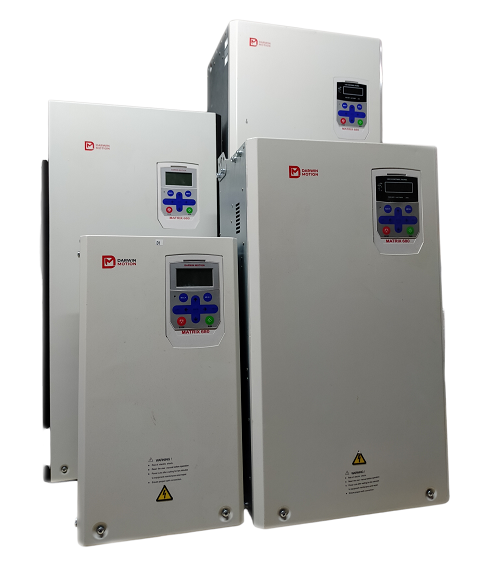Posted on 28th Dec 2024

In today’s modern HVAC (Heating, Ventilation, and Air Conditioning) systems, energy efficiency and precise control are paramount. Among the critical components of such systems is the Air Handling Unit (AHU), which plays a vital role in maintaining indoor air quality and comfort. The integration of Variable Frequency Drive (VFD) AC drives into AHU systems has emerged as a powerful solution for optimizing performance, enhancing energy efficiency, and providing better control over air circulation. Darwin Motion, a leader in the design and development of advanced motion control technologies, has been at the forefront of integrating VFD AC drives for AHU control.
An Air Handling Unit (AHU) is a crucial component in HVAC systems, responsible for regulating and circulating air within a building. It typically consists of fans, filters, heating and cooling coils, and dampers. The efficiency of an AHU directly impacts the comfort of building occupants and the overall energy consumption of the HVAC system. Traditionally, AHUs used constant-speed motors for their fan systems, but this approach often led to wasted energy and inadequate control over airflow.
Variable Frequency Drives (VFDs) offer a solution to these challenges by adjusting the speed of the motor based on the demand for airflow. Instead of operating the fan at full speed all the time, VFDs allow the motor to run at the most efficient speed needed to meet specific requirements. This not only reduces energy consumption but also enhances the overall system performance by ensuring that the fan operates within the optimal range for the required airflow.
Energy Efficiency: VFDs enable significant energy savings by matching the fan speed to the actual demand. Reducing the speed of the motor during periods of low demand can result in energy savings of up to 50% or more. The ability to precisely control the airflow, without overshooting or wasting energy, is a game-changer for modern HVAC systems.
Improved Comfort: VFD-driven AHUs can provide better temperature and humidity control. By adjusting the fan speed to match the cooling or heating demand, VFDs maintain the desired indoor conditions with minimal fluctuation. This results in a more comfortable environment for occupants.
Reduced Wear and Tear: By eliminating the need for the fan to run at full speed constantly, VFDs reduce mechanical stress on the fan motor and other components. This leads to longer service life and reduced maintenance costs, helping to extend the lifespan of the AHU system.
Precise Control: VFDs provide fine-tuned control over the airflow, pressure, and temperature. Darwin Motion’s VFD AC drives are designed to offer seamless integration with building management systems (BMS), enabling real-time monitoring and adjustments based on changing conditions.
Compliance with Energy Regulations: With energy conservation regulations becoming stricter globally, building owners and facility managers are seeking ways to reduce their carbon footprint. VFD AC drives help AHUs meet energy efficiency standards and achieve sustainability goals by optimizing energy use.
Darwin Motion stands out as a trusted provider of VFD solutions for AHU control systems. The company’s VFD AC drives are engineered to meet the unique challenges faced by HVAC systems, including the need for energy efficiency, reliability, and precise control.
Advanced Control Algorithms: Darwin Motion’s VFD AC drives are equipped with sophisticated control algorithms that optimize motor performance in real time. This ensures that AHUs operate at the most efficient speeds under varying loads.
User-Friendly Interface: The VFDs come with intuitive interfaces that allow easy programming and customization to meet specific AHU requirements. Whether for residential, commercial, or industrial applications, the drives can be fine-tuned for maximum efficiency and comfort.
Robust Construction: Darwin Motion’s VFDs are built to withstand harsh operating conditions, ensuring long-term reliability. The drives feature advanced protection mechanisms against power surges, overheating, and other environmental factors, making them ideal for the demanding environments of HVAC systems.
Communication and Integration: Darwin Motion’s VFDs offer seamless integration with building automation and control systems (BAS/BMS). With support for various communication protocols, such as Modbus and BACnet, these drives can be easily connected to centralized control systems for enhanced monitoring and management.
Flexible Configuration Options: Whether for new installations or retrofitting existing systems, Darwin Motion offers a wide range of VFDs that can be adapted to different types of AHUs. This flexibility makes them an ideal solution for both small-scale and large-scale HVAC applications.
Several projects have demonstrated the success of Darwin Motion’s VFD AC drives in AHU systems. In commercial buildings, the installation of VFD-driven AHUs has led to substantial reductions in energy consumption, often resulting in payback periods of less than two years. In industrial settings, where air circulation demands can vary greatly depending on the production process, VFDs have allowed for better load management and smoother operation.
As the demand for energy-efficient and sustainable HVAC systems grows, VFD AC drives are becoming essential components for achieving both operational excellence and environmental goals. Darwin Motion’s advanced VFD solutions for AHU control are helping to set a new standard in energy efficiency, system reliability, and performance optimization. By embracing this technology, building owners and facility managers can reduce operational costs, enhance comfort, and contribute to a greener, more sustainable future.
With the continued innovation and development of VFD technology, the future of AHU control is promising, and companies like Darwin Motion are leading the charge toward smarter, more efficient HVAC systems.